I looked through my past poems in the morning and discovered I’d been writing the always somehow peripheral sonnet all along without understanding the forms of brief conclusive thought the poems had been taking so often in 14 lines without me.
—Bernadette Mayer, 1989
Since 2009 or so the sonnet has functioned in my work as a much needed, endlessly available container. Because of its condensed yet serial nature it easily accommodates whatever dimensions are being visited upon the poems. There were a scattered handful of sonnets present in my second book Stranger in Town (2010). It seemed the most attractive form and length for the endless rearranging of lines I was engaged with. At that point the sonnet still felt like a labyrinthine process in which one line would join to another creating blinding light or transparent walls, then suddenly the next collision would result in an ivy covered dead end. My line at the time felt less limber than it does now. I considered the lines to be long planks thrown down, whereas now each line has at least three bites, black holes, or echo chambers. I mean to say that several individual textures are contained within each line.
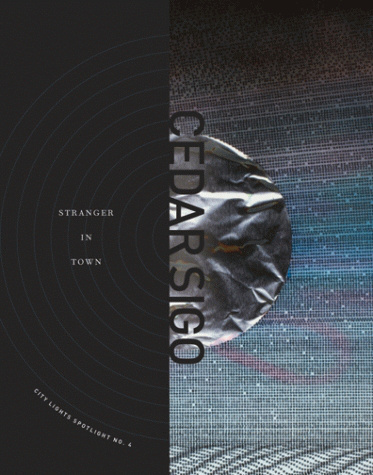
It was toward the end of putting together Stranger in Town that I began to recognize the sonnet as hiding within other more predominate forms. My poem "(Untitled) Nijinsky," the last in that book, began and ended as an email to the poet Micah Ballard. It was really just friendly riffing in a veiled manner regarding scandalous recent parties and behaviors. I think it was the line length and slab-like appearance of the email that tipped me off to the fact that this tone was now available upon demand and could have a long-lasting presence within my work. I stole the title of the poem from a Jess catalog issued by Tibor De Nagy around that time; all the works inside were untitled but had a single identifying image from the collages in parenthesis. The writing felt like dancing on air, as I was not recognizing its flow as poetry, per se. It only began to harden, to take the light and shine in retrospect.
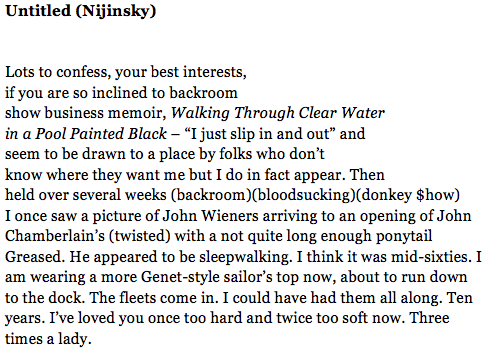
My last book Language Arts (2014) contains a sequence of 18 sonnets (more than I actually remember writing) and I chose to place them at the very center of the book. I wanted to disguise the fact of writing them. The poem “Taken Care Of” had initially been given short James Schuyler-like line breaks, but when performing it in front of an audience I saw that I was pausing at intervals that actually formed a sonnet. I think my disguising of its true sonnet nature must have stemmed from the form feeling so available that I questioned whether I was upholding the stress and glowing brick-like quality of traction that I associated with the masters of the form (Berrigan, Mayer, Coolidge, Hejinian, Greenberg, Mallarmé, Donne, Shakespeare, and Dante).
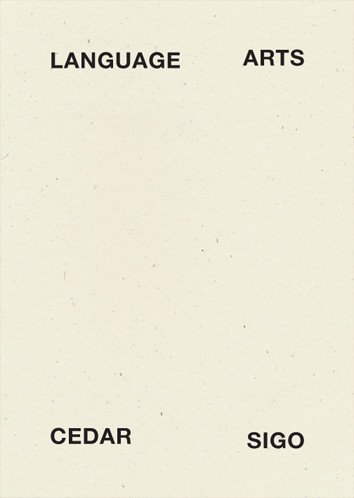
Eventually I softened and began to liken their composition to pulling on my favorite worn out, see-through t-shirts from the laundry, and the guilt began to dissipate. Soon I began to use the form to invite process and experimentation. In retrospect it seems I was actually trying to out-run my own voice. I was employing the sonnet as a vessel to bang my head against. Collage was often a mainstay within this mode and felt married to outright thievery. I was working toward the poet’s dream of gaining traction on demand. The sequence became a place to demonstrate the manner in which I was hearing language on that particular day. There was no perfectly timed echo to bind them all together, as in Ted Berrigan’s sonnets. There was no consistent, curvaceous arc of erotic humor, as in Bernadette Mayer’s book of sonnets. I actually tried to mix it up as much as possible. Now I wonder if I engaged so fully in this form with a secret wish to destroy it.
In my poem “Paris” (which runs to a total of 19 lines) the first 12 are spent looking back over a recent (first) trip to Paris and how uniform the city looked in all of its stone grandeur, with its shadows inviting you in to lurk about. The first half also remembers fondly the solitude gained by traveling alone for weeks and not speaking the language.
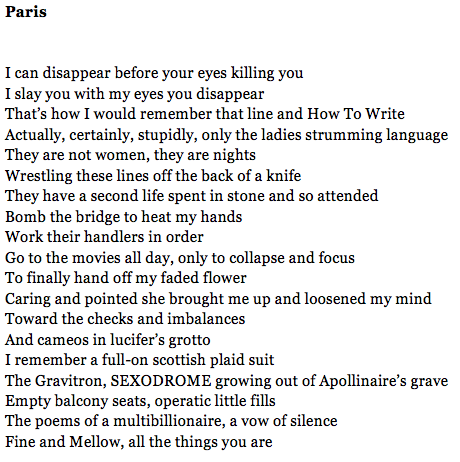
The last six lines where born of an assignment that was hanging over my head at the time. The artist Frank Haines had asked me to write “An Inventory of Lucifer’s Grotto.” The possibilities of the assignment felt so lush that I assumed he wanted it written in prose, and I froze under the weight of its drama. It almost seemed the concept would be best served if it was realized as an installation in a gallery or as a short animated film. I suddenly remembered Frank’s request as I was nearing the end of “Paris,” so I just began to list a set of creepy emblematic objects without any worry of providing context. The trick was imagining each of the objects trapped under glass as in a museum. I was surprised that this abbreviated, clipped measure seemed to serve the material best. In the end it took several months and two weeks in Europe to access the material and to include it as the last phase of a sonnet.
As for other sonnets in Language Arts, I used various prompts and veils to access new tones within the writing. “Panels for the Walls” was constructed by lifting several lines verbatim from The Jade Mountain, my favorite collection of ancient Chinese poetry, translated by Witter Bynner. The poems contained such gilded, steaming, over-the-top imagery that it was fun to attempt the same pitch of tone as the translator. I stole lines from Tu Fu, Li Po, and others and didn’t hesitate to place them all into one golden poem. The result of this particular sonnet was a feeling of calling up the color and physical contours of a bygone landscape.
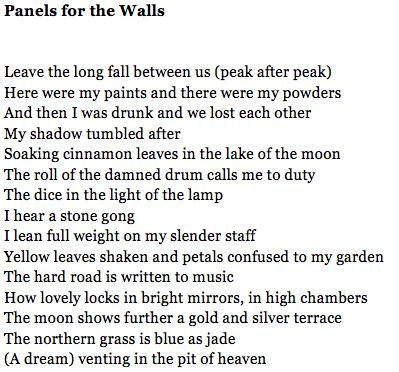
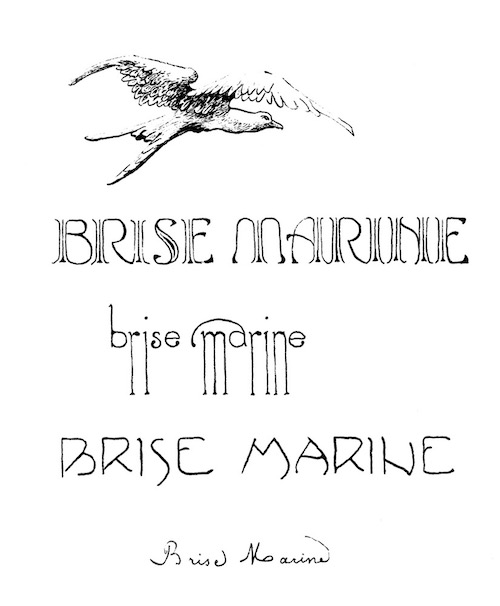
Further along in the book I attempted a translation of Mallarme’s “Brise Marine.” I was attracted to its exalted reputation as a sonnet that was supposedly impossible to translate into English. A few of my friends, the poet Bill Berkson and writer/curator Larry Rinder, had given it a try and generously shared their results. Bill described his own translation as feeling “interim, perhaps as all translation should.” Larry’s managed to preserve the original French structure of rhyming couplets. Their fearlessness inspired me to try my own take and a few months later I invited 20 other contemporary poets to attempt their own translation. I sought out writers and artists such as Garrett Caples, Jennifer Foerster, Anelise Chen, Colter Jacobsen, Will Yackulic, and Tenaya Nasser-Frederick. I soon gathered them all up, wrote a short introduction and published them under Frank Haines imprint Heinzfeller Nihilist in time for the LA Art Book fair. Here is a tiny bit from the introduction followed by my own translation:
Mallarme’s track changes often and without warning, but still somehow maintains the sense of an aged storyboard, how its colors being bleached by the sun only turns them brighter. (Kenneth Anger’s early film Fireworks also springs to mind.) The pleasure of translation comes as the poet begins to flail around in the trenches of a foreign syntax, obliterating all sense of time.
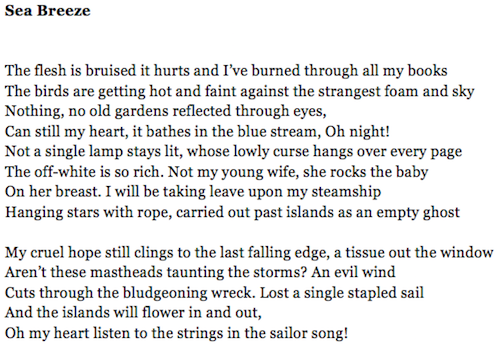
Hopefully the poet can provide several examples of surface that run concurrent to the narrative, the totality of the 14 lines. One should attempt to secure both point and counterpoint; only then does the music begin to reflect and to refract. I recently thought of my ideal sonnet as something like shooting a pistol into a hall of mirrors, an obvious homage to the ending of The Lady from Shanghai. In this case the bullet provides for both containment and distortion, a passage in which to catch your breath after achieving the impossible.

No comments:
Post a Comment